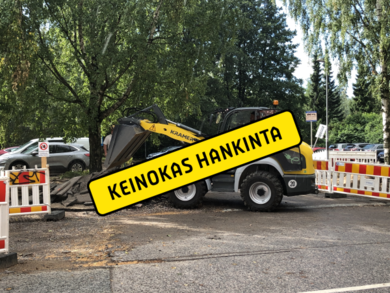
Pilot of an emission-free construction site: Kulosaari park road contract - Case City of Helsinki

BACKGROUND INFORMATION
Procuring party
City of Helsinki, Urban Environment Division
Object of procurement
Turning Kulosaaren puistotie into a cycling street, total contract
Procurement value
2 462 000 euros (VAT 0%)
Objective of the procurement
One of the objectives of the Carbon-neutral Helsinki 2035 plan of the City of Helsinki is to reduce carbon dioxide emissions at worksites.In addition to this, Helsinki wants to reduce harmful local emissions and engine noise from worksites, along with the negative effects of these on the people living, moving and working in the area. To achieve these objectives, the City of Helsinki is trying to increase the use of zero-emission and low-emission machinery and transport vehicles in construction projects. At the same time, these actions also meet the goals of the Green Deal for worksites, which the City Of Helsinki signed together with the Ministry of the Environment, Senate Properties, and the Cities of Espoo, Turku and Vantaa in September 2020.
Operators involved in the procurement
The Construction Contracting Services of the Urban Environment Division was in charge of the procurement and acted as the client in the project. The participants of the procurement preparations and the market dialogue that preceded them included the head of construction contracting, the development manager, the procurement specialist and the project director from the Construction Contracting Services, and the environmental inspector, environmental planner and project staff from the City’s Environmental Services. The contractor selected was VM Suomalainen Oy.
Background to the procurement
The Kulosaaren puistotie boulevard in Kulosaari, Helsinki, was to be renovated into a cycling street as a part of Itäbaana, which is one the main cycling routes to the city centre. On a cycling street, traffic moves on cyclists’ terms, meaning that cars adjust their driving style and speed to the cyclists’. Vehicles move one after the other, avoid overtaking and keep their speed at 30km/h, at the maximum. A cycling streetalso improves the safety of pedestrians as the pavements are reserved for walking only.
The project contributes to the implementation of Helsinki’s new Bicycle Action Plan, the goal of which is that Helsinki become a cycling city where cycling is possible year-round and for all ages, and the proportion cycling accounts for of all modes of transport be at least 20percent by 2035. The Bicycle Action Plan primarily focuses on ways of improving the different areas of the cycling infrastructure. The most important measure highlighted in the plan is more rapid implementation of the target cycling network.
In addition to these qualities, the Kulosaaren puistotie project was also a testing field for zero-emission operations, one of the pilot sites of the zero-emission worksites in accordance with the Carbon-neutral Helsinki plan, with the aim to reducing worksite emissions. The worksite machinery was fuelled by renewable electricity or diesel and produced significantly less in the way of carbon dioxide and local emissions.
PROCUREMENT PROCESS
Preparation of the procurement and market dialogue event
In December 2019, the Urban Environment Division of Helsinki held a market dialogue event aimed at infrastructure contractors interested in submitting tenders for the zero-emission infrastructure worksites of the City of Helsinki. The invitation to the event was published in the Hilma system, in addition to which the contractors received invitations by e-mail.
At the event, the Helsinki’s carbon neutrality goals for 2035 were presented extensively, and participants received information about what zero-emission worksites are and what role they play in achieving the goals. In addition to this, the environmental criteria for machinery and the opportunity to use electric machinery at worksites were discussed.
The market dialogue involved eight contractors. City representatives also talked to the contractors one-on-one. They mostly agreed that the industry is developing towards zero-emission worksites. The topics discussed included the current availability and prices of electric machinery. Based on the discussions, a call for tender was finished and published in spring 2020. The market dialogue provided certainty of the previously suggested minimum criteria for low-emission worksites. It also added the finishing touches to the scoring system for electric machinery.
Criteria and grounds for comparison for the procurement target
The following minimum criteria were used for the procurement:
1. The contractor must have a valid and certified environmental management plan (e.g. RALA Certification or similar) verified by a third party in order to reduce the environmental impact of the operations and improve the energy efficiency of heavy transport equipment, as well as routines for monitoring and reporting on these issues.
2. Worksite machinery must meet the requirements of STAGE IV emission standards, at the minimum. Worksite machinery refers to the following:
- wheel loaders
- excavator loaders
- skid steer loaders
- wheel excavators
- crawler excavators
- telescopic handlers
- tractors
- smooth rollers
- road graders
- multi-function machines
- cranes
- forklift trucks
3. The heavy transport equipment used by the contractor must meet the emissions requirements of EURO VI class, at the minimum.
4. All machinery must be either electric, or the fuel used by themachinery and the heavy transport equipment of the contractor must be non-fossil. Acceptable non-fossil fuels include bio gas, hydrogen, ethanol (e.g. ED95) and renewable HVO diesel or motor oil in accordance with the EN 19540 standard.
5. The electricity used on the site must be produced using renewable energy sources and a certificate of the origin of the electricity must be presented.
6. The heating of the worksite must be implemented with district heating, fossil-free biofuels or electricity from renewable sources.
7. All the small machinery on the site (power ≤ 4kW) must be electric.
In addition to this, rocks must loosened either through wedging or using a rock fracturing chemical (‘snail dynamite’).
The contractor must draft an environmental plan for the site and have it approved by the developer before signing the contract. The environmental plan of the worksite must specify operating methods to prevent negative environmental impacts and guide the measures on the site towards a more environmentally friendly direction.
Environmental plan monitoring reviews must be held during the project to oversee the actual consumption and compliance with the regulations set. In addition to this, the contractor must prepare reports on how the low-emission worksite has affected the implementation and costs of the work and present them at the follow-up inspections.
In addition to the minimum criteria, the number of electric machines was used for comparison:
The contractor with the most economically advantageous tender will be selected. The most economically advantageous tender is the one with the best price-quality ratio out of the tenders that meet the developer’s criteria. Price accounts for 70% of the comparison, and quality for 30%.
Quality points for overall economy are awarded for electric machinery. The contractor may enter up to five electric machines in the scoring.
The quality score is calculated in the following way:
- Five electric machines, 100 p.
- Four electric machines, 80 p.
- Three electric machines, 60 p.
- Two electric machines, 40 p.
- One electric machine, 20 p.
- No electric machines, 0p.
As an appendix to their tender, the contractor must upload a report on the electric machinery submitted for scoring. This report must include proof that the machinery submitted fulfils the criteria for electric machinery.
Contract terms and conditions
The project was a total contract in accordance with the General conditions for building contracts YSE 1998 RT 16-10660, with exceptions mentioned in the contract plan.
Potential challenges
One of the challenges was setting criteria that are sufficiently ambitious for achieving emissions reductions while also keeping them at a realistic level without competition being too restricted, and with small companies being able to participate in the tendering. Since the availability of large electric excavators, for example, is still very limited, delivery times are long and prices are several times the prices of machinery using combustion engines, it was determined that demanding such machinery is not feasible. At the same time, we still wanted to encourage the use of electric machinery as far as it was available. It is to be expected that the increasing demand will also increase the supply in the future.
Procurement results
As a result of successful tendering, four fully electric machines were used at the Kulosaari worksite (three 4.2-tonne wheel excavators and one mini-excavator), and the rest of the equipment used renewable HVO diesel, apart from a few exceptions. The machinery proved even cleaner than expected in terms of emissions levels: for example, most of the asphalt pavers not included in the criteria were at STAGE IV level, and one of the drill carriages was at STAGE V level. The pilot project provided both the contractor and the client with lessons on the practical challenges posed by electric machinery: in the future, the limitations of the battery duration and charging times can be better taken into consideration in the project and work stage planning.
The list of machinery and equipment used in the project was updated as new machinery was brought onto the worksite. The fuel and electricity consumed at the worksite was reported monthly at the worksite meetings. One of the goals of the pilot project was testing the collection of new kinds of data to assess emissions impact. In their current form, there is no systematically collected data available on the emissions of construction sites or the fuel volumes used there, for example. In Kulosaari, monitoring and reporting was developed in cooperation between the client and the contractor.
When most of the machine work of the Kulosaari pilot was completed, the co-implementers of the CRIA project, VTT Technical Research Centre of Finland and the City Of Helsinki, prepared rough calculations of the project’s emissions compared to a hypothetical ‘conventionally implemented’ project based on the data provided by the contractor regarding fuel and electricity consumption and operating hours of the machinery. The emissionscalculations were also considered important by the contractor, since when new requirements or targets are set, assessing their results must be possible in order to verify the impact and profitability of the investments. According to the emissions calculations, the project’s emissions equated to about 42% of the emissions of a conventional project, and the emissions saved amounted to over 106tonnes of CO2e, which is equal to the annual carbon footprint of around a dozen Finnish people.
Procuring party’s comments
The requirements did not affect contractors’ willingness to submit tenders or the tendering prices –a regular number of tenders were received.
Even though environmental criteria for machinery and transport equipment have been tested in the past, the entity of zero-emission worksites is still new for both procurement clients and contractors. This is why it was also key to have market dialogue withthe contractors. It also offered the client the opportunity to chart the market’s ability to meet the criteria planned. For contractors, the market dialogue event offered a chance to ask questions and provide comments.
The Kulosaaren puistotie project was a new kind of a pilot for a zero-emission worksite where both the developer and the contractor wanted to learn things for the future. Based on the data and experiences collected of this pilot, we can further develop the criteria for zero-emission worksites and the reporting procedures of worksites, for example.
At the same time, we can impact the market by creating demand for low-emission and zero-emission machinery. The practices of zero-emission worksites are being developed in cooperation with contractors, and dialogue will also continue in the future.
Sharing knowledge
The City of Helsinki has decided to apply minimum criteria prepared for this procurement to all of its future outsourced infrastructure/street construction projects. By modifying the criteria as needed, they can be used for various types of construction. With the Green Deal signed in September 2020, the practices of zero-emission worksites will be gradually applied to the work of the entire City. Next, we will expand the pilots to housing construction and maintenance projects.
More information
Related links:
- Ministry of the Environment, Senate Properties and the cities of Helsinki, Espoo, Turku and Vantaa sign a voluntary agreement to reduce emissions at construction sites
- The Green Deal agreement to reduce emissions at construction sites (in Finnish)
Contact persons
Acting Unit Manager Liisa Taskila
Project Coordinator Hanna-Mari Juvonen
hanna-mari.juvonen@hel.fi
Environmental Planner Satu Turula
satu.turula@hel.fi



